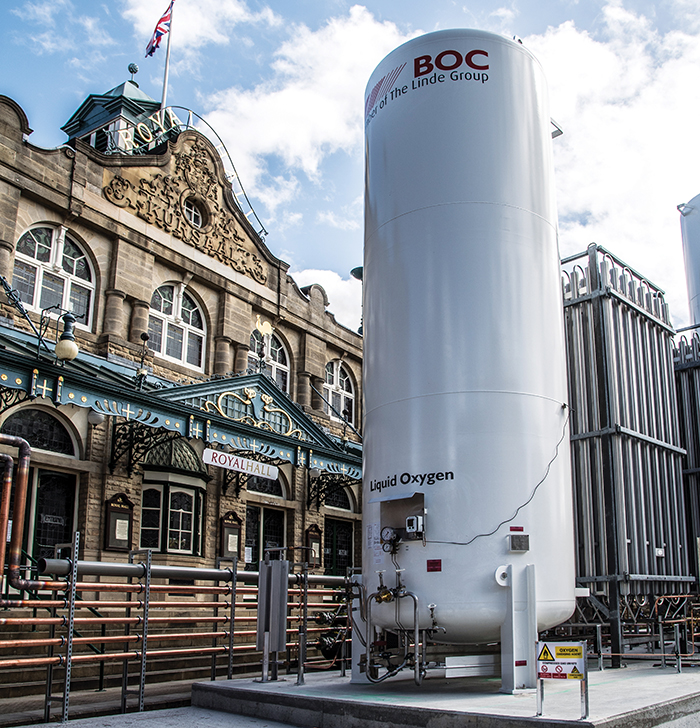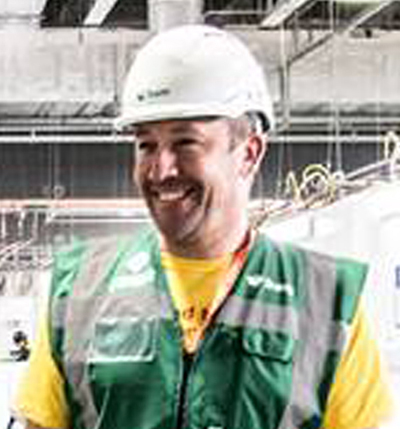Harrogate Convention Centre required extensive reconfiguration by BAM to construct Yorkshire’s Nightingale hospital, a process completed in just nine days. Will Mann reports.
Harrogate Convention Centre is used to hosting major events. Various political party conferences, concerts and even the 1982 Eurovision Song Contest have been held there over the years. But with the coronavirus outbreak, a different kind of stage had to be created at the North Yorkshire venue.
With over 17,000 sq m of space across its eight exhibition halls, the centre was chosen for the 500-bed NHS Nightingale Hospital Yorkshire and the Humber, after a lengthy search around the county. BAM Construction was appointed as main contractor and project manager Matthew Garnett was involved from the outset.
“On Monday 23 March, I received a call from my director, asking if I’d be willing to look at the project. I’d been working from home for two weeks so was it great to get out. The next day, I went with our building services director Adrian Cairns to look round Church Fenton airfield and then Leeds Arena, along with the army and Craige Richardson, director of estates at Leeds Teaching Hospitals Trust, who we knew from the P22 framework. But neither venue was suitable for a temporary hospital.
“Then on Friday we walked round Harrogate Convention Centre. And stayed there for most of the next two weeks! From that moment on, we worked for 14 to 15 hour days and only went home to sleep.

Project team
Main contractor: BAM
Architect: BDP
Project manager: Arcadis
Structural engineer: BAM Design
M&E engineer: Silcock Leedham
M&E contractor: NG Bailey
“We pulled our key suppliers together in barely a morning. Every company was happy to be asked and some contacted us and wanted to be involved so they could be doing something. BAM is very lucky to have a strong local supply chain and everyone felt they were building the hospital for their family and friends.”
The input of BAM’s in-house M&E team played a key role on the project, including the design, says Cairns.
“The eight exhibition halls are quite odd shapes and it was difficult to use the space efficiently. The design team worked round the clock to get the layout and clinical flow of the spaces correct, collaborating with clinical leads and M&E services. The halls were divided into eight wards and once we had the right design for the first one, we could quickly repeat the design concepts in the other seven.
In numbers: NHS Nightingale Hospital Harrogate
- 500 beds
- 9 days construction
- 400 workers
- 22km of copper pipe
- 45 tonnes of oxygen tanks
“The NHS produced a ‘Standard Operating Procedure’ specifically for the covid response requirements for clinical areas. This document, along with the standard Health Building Notes and Health Technical Memoranda were used to inform the design.
“The existing services infrastructure was not designed for a 24/7 operation, so a huge amount of new M&E had to be designed and installed to suit the clinical requirements, ranging from complete med gas installation to new CCTV systems. Any areas with long lead times for equipment were prioritised, such as the cold rooms for the pharmacy and the morgue.
Design challenges
“Infection prevention and control (IPC) was difficult in a temporary hospital. We agreed that up to 2.5m high would be a clinical environment, but above that it was impossible to achieve, so that decided the height of all partitions and bed pods. We designed the bays with our supply chain and ended up with 9 sq m for each bay.
“One of the biggest design challenges was the PPE ‘don and doff’ areas for clinical staff. As there’s a huge risk of the virus being on PPE when it’s being put on or taken off, this is a painstaking process which takes seven minutes per person. So we had to create areas 8m long by 4m wide in every ward, where a ‘conveyor belt’ system operates, to allow clinical staff to don or doff their PPE while still maintaining 2m social distancing.”

When it came to construction, a huge amount of work was required to adapt the convention centre for its new healthcare function, continues Cairns. “There wasn’t a single M&E service in the existing building that didn’t need to be modified or newly installed on the project. The existing ventilation systems and main plant have been fully cleaned inside and out, modifications made to ductwork routes, fire dampers added, and much more – to ensure clinical spaces are serviced with the right quality of air.
“We’ve added new mains cold water infrastructure and hot water services to all clinical spaces, ‘pumped’ drainage installation, IT systems including two new server rooms, six new electrical generators, intercom system…”
“It wasn’t always easy to source the materials. With medical grade copper pipe and associated valves, we were having twice daily conversations with suppliers to check progress on manufacturing and delivery. Similarly for clinical grade electrical trunking and socket outlets. Oxygen enrichment monitors and alarms had to be delivered by hand from Germany.”
Where possible, elements of the M&E build were modularised, with NG Bailey’s nearby factory in Bradford working 24 hours a day, says Garnett.
“Modular pipe services for the medical gas systems helped the speed of installation. Bedhead electrical services were prefabricated offsite for the bed bays. Water heaters were mounted on to backboards for almost all the 127 sinks.

“The existing services infrastructure was not designed for a 24/7 operation, so a huge amount of new M&E had to be designed and installed to suit the clinical requirements.”
Matthew Garnett, BAM
“One lesson from the project is just how fast you can build when you modularise elements like M&E.
“The biggest pieces of kit installed were the oxygen tanks, these hold 45 tonnes of oxygen and stand 9m tall, outside the centre’s grand Royal Hall entrance. We had to involve statutory authorities, Yorkshire Water in this case, which is normally a slow process, but they were on site the day after our call, excavating the roadways, making sure their valve systems were up to scratch.”
Sequencing work
With 400 workers on site at peak, BAM planned work carefully to make social distancing easier to control, says Garnett.
“We were able to use separate suites for project management and architects worked remotely using videoconferencing and file sharing. We sequenced work so that design and construction planning happened during the day, then the night shift could proceed without having to stop and worry about what came next.
“There was some demolition work, dismantling units in storage halls, where it was always going to be difficult to maintain the 2m social distancing rule. But our demolition contractor brought in some workers who lived together, and they carried out the dismantling in a team of four.
“We took workers’ temperatures every day, but nobody showed any covid-19 symptoms.”
Nine days after work started on site, the reconfigured convention halls were ready to receive their first patients. It was officially opened by Captain Tom Moore on 14 April, though the hospital is yet to admit any covid-19 patients. Meanwhile, Garnett is back working from home on another project.
“It was one heck of an experience, quite emotional. Having the army there as a presence makes you understand how serious the situation is. But there was a genuine comradery evident on site among everyone involved.”










